Search Result
Results for "
Benzamide
" in MedChemExpress (MCE) Product Catalog:
4
Isotope-Labeled Compounds
| Cat. No. |
Product Name |
Target |
Research Areas |
Chemical Structure |
-
- HY-Z0283
-
|
Benzenecarboxamide; Phenylamide
|
Endogenous Metabolite
PARP
|
Others
|
|
Benzamide (Benzenecarboxamide) is a potent poly(ADP-ribose) polymerase (PARP) inhibitor. Benzamide has protective activity against both glutamate- and methamphetamine (METH)-induced neurotoxicity in vitro. Benzamide can attenuate the METH-induced dopamine depletions and exhibits neuroprotective activity in mice, also has no acute effect on striatal dopamine metabolism and does not reduce body temperature .
|
-
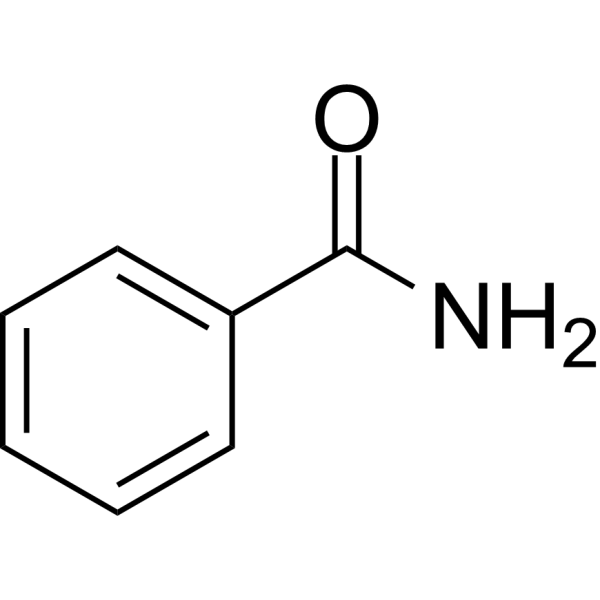
-
- HY-Z0283S
-
|
Benzenecarboxamide-15N; Phenylamide-15N
|
Endogenous Metabolite
PARP
|
Others
|
|
Benzamide- 15N is a 15N-labeled Benzamide. Benzamide inhibits poly(ADP-ribose) polymerase (PARP)[1][2].
|
-
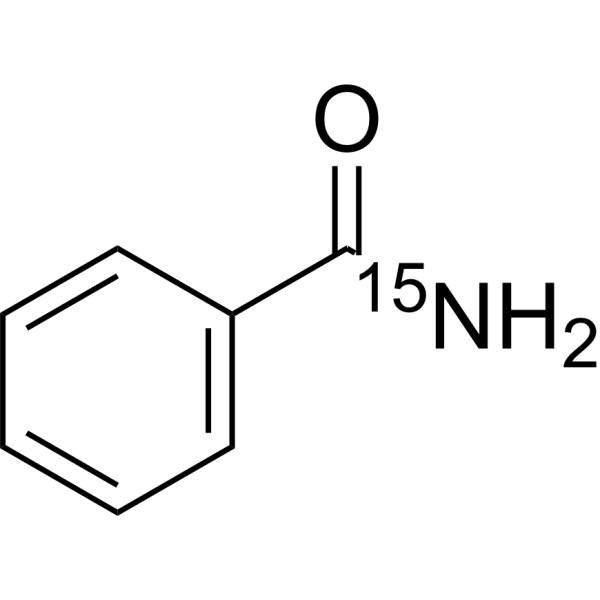
-
- HY-B1224
-
|
2-(Hexyloxy)Benzamide
|
Fungal
|
Infection
|
|
Exalamide (2-(Hexyloxy)benzamide), an arenecarboxamide, is a potent antifungal agent .
|
-
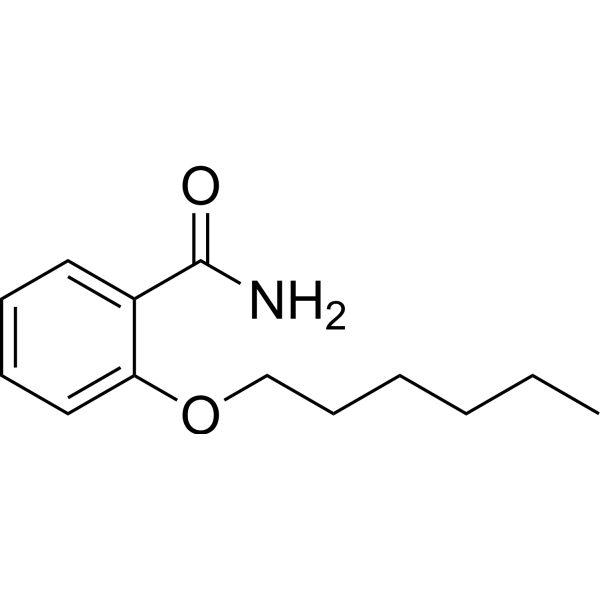
-
- HY-U00415
-
|
|
Dopamine Receptor
mAChR
|
Neurological Disease
|
|
Benzamide Derivative 1 is a benzamide derivative from patent EP0213775A1, compound 18. Benzamide Derivative 1 may be useful in treatment of gastrointestinal disorders.
|
-
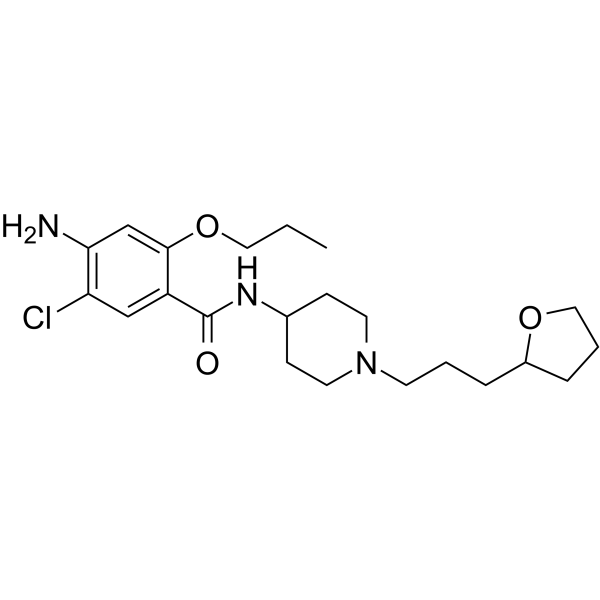
-
- HY-147256
-
-

-
- HY-145488
-
|
|
ADC Linker
|
Cancer
|
|
MethylCBI-azaindole-benzamide-MOM-Boc-ethylenediamine-D is a cleavable ADC linker used in the synthesis of antibody-drug conjugates (ADCs) .
|
-
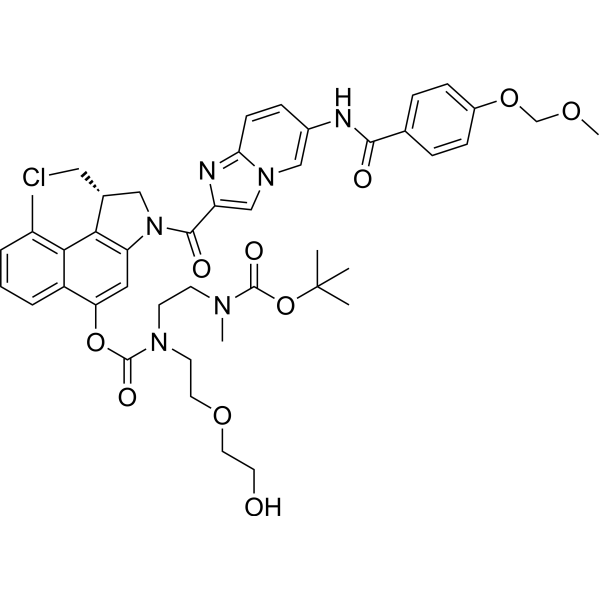
-
- HY-W128037
-
-

-
- HY-B1883S
-
|
|
Isotope-Labeled Compounds
|
Others
|
|
3,5-Dichloro-N-(2-methylbut-3-yn-2-yl)benzamide-d3 is the deuterium labeled 3,5-Dichloro-N-(2-methylbut-3-yn-2-yl)benzamide[1]. 3,5-Dichloro-N-(2-methylbut-3-yn-2-yl)benzamide-d3 is a click chemistry reagent, it contains an Alkyne group and can undergo copper-catalyzed azide-alkyne cycloaddition (CuAAc) with molecules containing Azide groups.
|
-
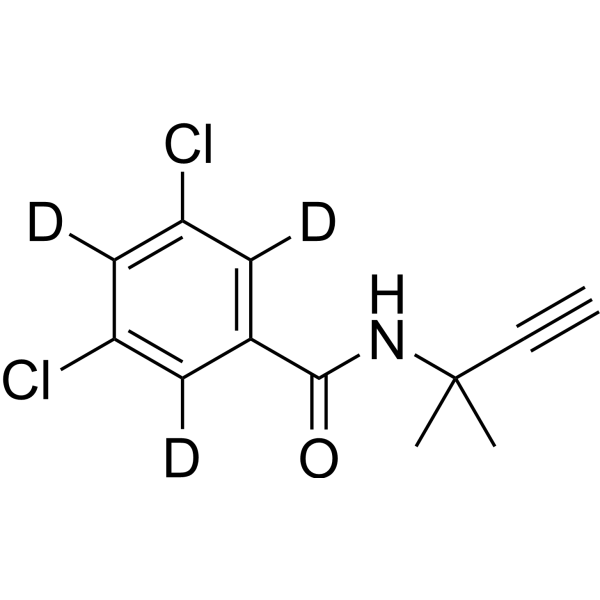
-
- HY-134753
-
|
4-Amino-N-(4-trifluoromethylphenyl)Benzamide
|
COX
|
Inflammation/Immunology
|
|
Teriflunomide impurity 3 (4-Amino-N-(4-trifluoromethylphenyl)benzamide) is a selective COX-1 inhibitor with an IC50 of 30 µM. Teriflunomide impurity 3 is less active against COX-2 (IC50>100 µM) .
|
-
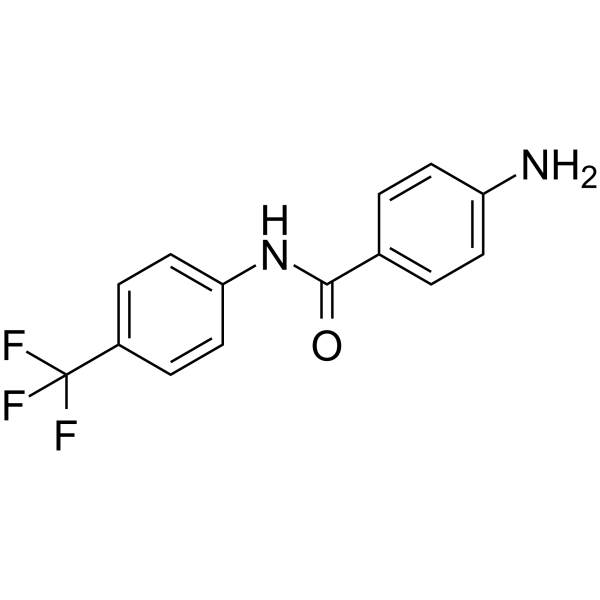
-
- HY-Q49697
-
-
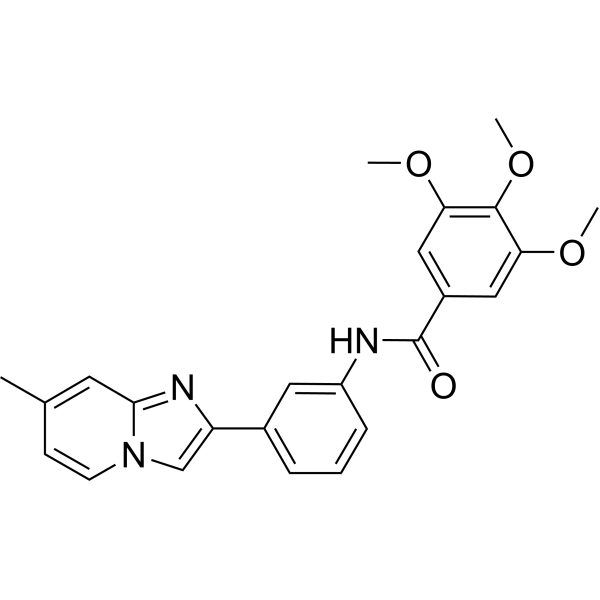
-
- HY-149800
-
|
|
PARP
Apoptosis
Caspase
|
Cancer
|
|
PARP-1-IN-3, a benzamide derivative, is a potent PARP-1 inhibitor with IC50 values of 0.25 nM and 2.34 nM for PARP-1 and PARP-2, respectively. PARP-1-IN-3 induces apoptosis and arrest cell cycle at G2/M phase. PARP-1-IN-3 can be used in research of cancer .
|
-
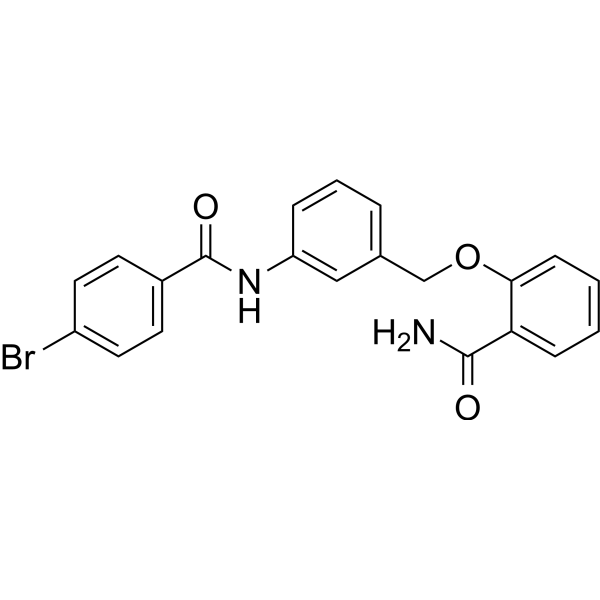
-
- HY-U00020
-
|
|
Others
|
Metabolic Disease
|
|
AU-224 is a benzamide derivative used as a promising gastrointestinal prokinetic agent without significant side effects.
|
-
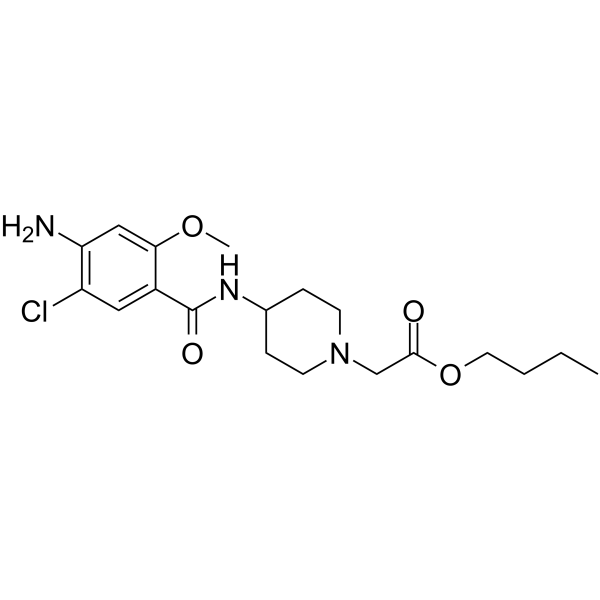
-
- HY-B1059
-
|
RV-12309; S-(-)-Sulpiride
|
Dopamine Receptor
|
Neurological Disease
|
|
Levosulpiride (RV-12309) is the (S)-enantiomer of sulpiride, which is a D2 receptor a antagonist, an atypical antipsychotic agent of the benzamide class.
|
-

-
- HY-12505
-
CX546
2 Publications Verification
|
iGluR
Autophagy
|
Neurological Disease
|
|
CX546 is a first-generation and selective benzamide-type positive AMPAR modulator. CX546 is a prototypical ampakine agent and has antipsychotic effects .
|
-

-
- HY-100963
-
|
|
|
|
|
U-54494A is a benzamide derivative related to κ-opioid receptor agonists, U-54494A has an anticonvulsant activity .
|
-
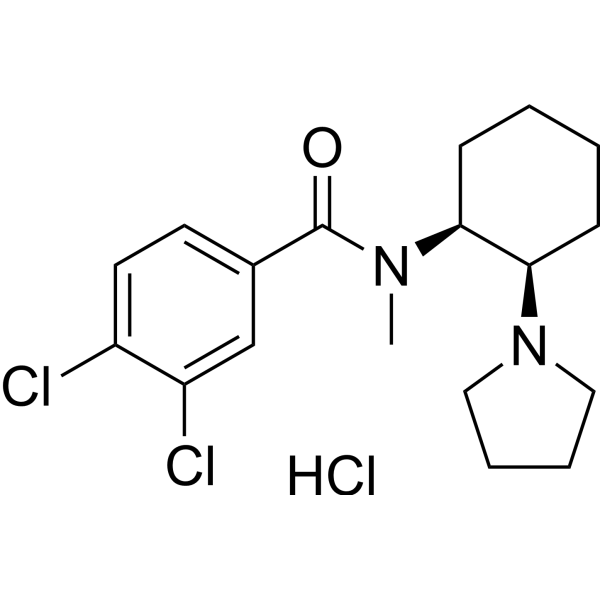
-
- HY-112731
-
-
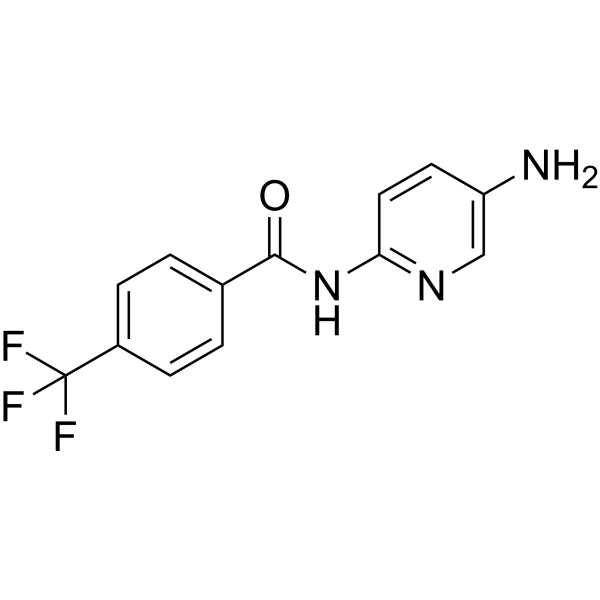
-
- HY-120469
-
|
|
JAK
|
Inflammation/Immunology
|
|
GDC-046 is a potent, selective, and orally bioavailable TYK2 inhibitor with Kis of 4.8, 0.7, 0.7, and 0.4 nM for TYK2, JAK1, JAK2, and JAK3, respectively .
|
-
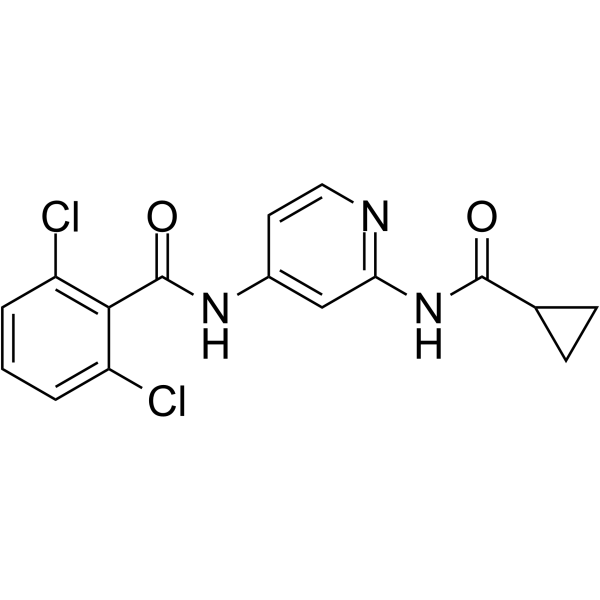
-
- HY-B0068
-
|
Y-25130 hydrochloride
|
5-HT Receptor
|
Neurological Disease
|
|
Azasetron (Y-25130) hydrochloride, a benzamide derivative, is a potent and selective 5-HT3 receptor antagonist. Azasetron is used in the study for Chemotherapy-induced nausea and vomiting (CINV) .
|
-

-
- HY-B1059S
-
|
RV-12309-d3; S-(-)-Sulpiride-d3
|
Isotope-Labeled Compounds
Dopamine Receptor
|
Neurological Disease
|
|
Levosulpiride-d3 is the deuterium labeled Levosulpiride. Levosulpiride (RV-12309) is the (S)-enantiomer of sulpiride, which is a D2 receptor a antagonist, an atypical antipsychotic agent of the benzamide class[1][2].
|
-

-
- HY-B0732S
-
-
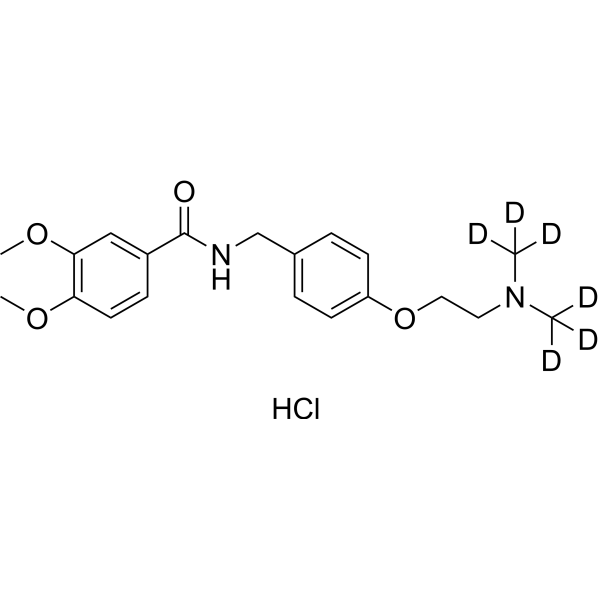
-
- HY-B1019
-
|
|
Dopamine Receptor
|
Neurological Disease
|
|
Sulpiride is an orally active dopamine D2/D3 receptor antagonist. Sulpiride is an atypical antipsychotic agent of the benzamide family. Sulpiride can be used in research into anxiety, depression and breast cancer .
|
-
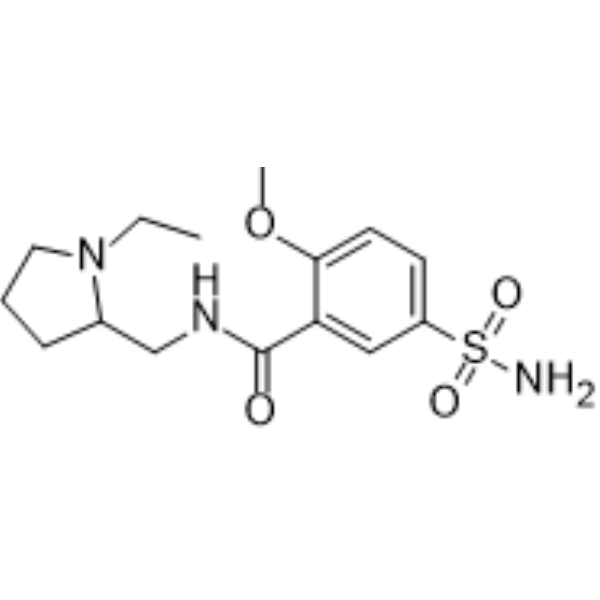
-
- HY-103414
-
|
|
Dopamine Receptor
|
Neurological Disease
|
|
Raclopride is a dopamine D2/D3 receptor antagonist with potential antipsychotic effects. Raclopride binds to D2 and D3 receptors with Kis of 1.8 nM and 3.5 nM, respectively .
|
-
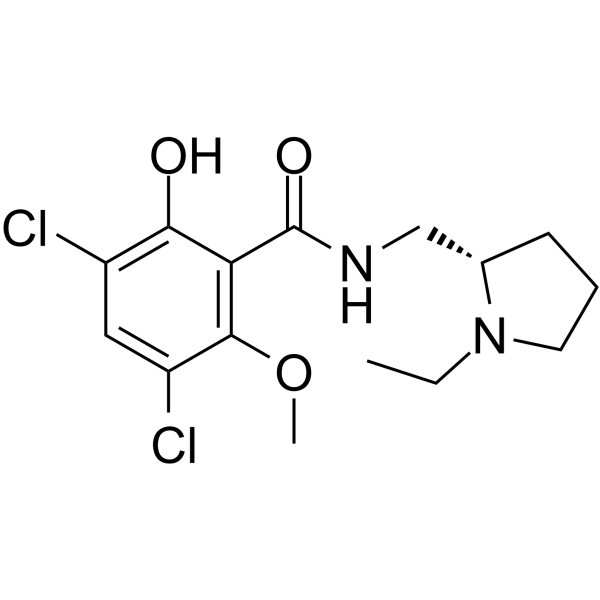
-
- HY-108976
-
|
|
Dopamine Receptor
|
Neurological Disease
|
|
Raclopride tartrate is a selective dopamine D2/D3 receptor antagonist with potential antipsychotic effects. Raclopride tartrate binds to D2 and D3 receptors with Kis of 1.8 nM and 3.5 nM, respectively .
|
-
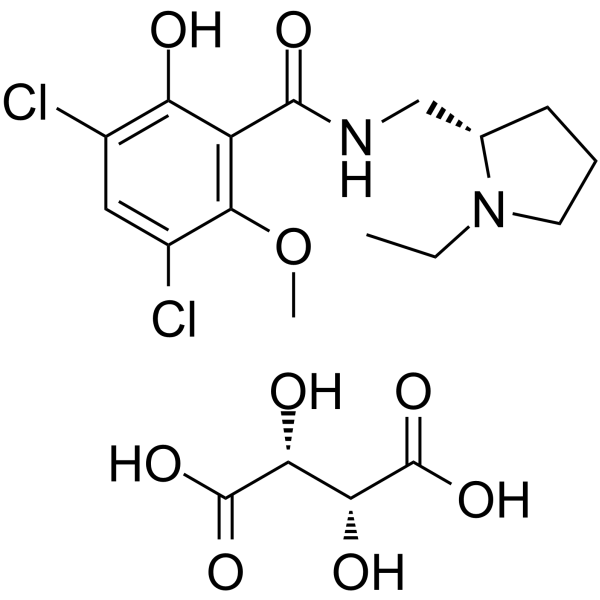
-
- HY-151370
-
|
|
Cholinesterase (ChE)
|
Neurological Disease
|
|
AChE-IN-26 (compound 4a) is an AChE (acetylcholinesterase) inhibitor with an IC50 value of 0.42 μM. AChE-IN-26 can be used for the research of Alzheimer’s disease .
|
-
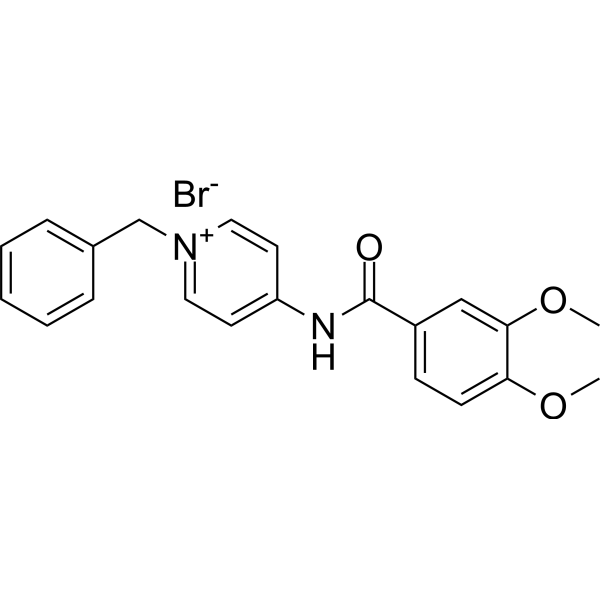
-
- HY-155597
-
|
|
Phosphatase
|
Metabolic Disease
Inflammation/Immunology
Cancer
|
|
h-NTPDase8-IN-1 (compound 2d) is a sulfamoyl-benzamides based and selective inhibitor for h-NTPDases8 (IC50=0.28 μM). h-NTPDases8 is involved in a variety of physiological and pathological functions,such as thrombosis,diabetes,inflammation,and cancer .
|
-
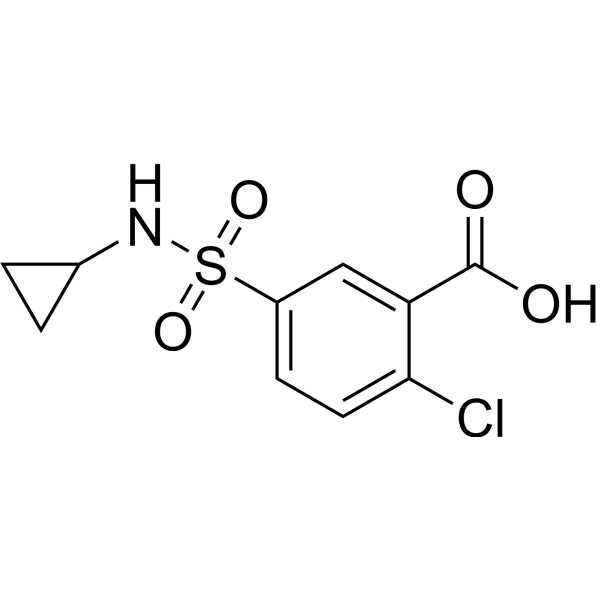
-
- HY-112547
-
|
CRT0066051
|
PKD
|
Others
|
|
CRT5, a pyrazine benzamide, is a potent and selective inhibitor for all three isoforms of PKD in endothelial cells treated with VEGF (IC50s = 1, 2, and 1.5 nM for PKD1, PKD2, and PKD3, respectively). CRT5 decreases VEGF-induced endothelial migration, proliferation and tubulogenesis .
|
-
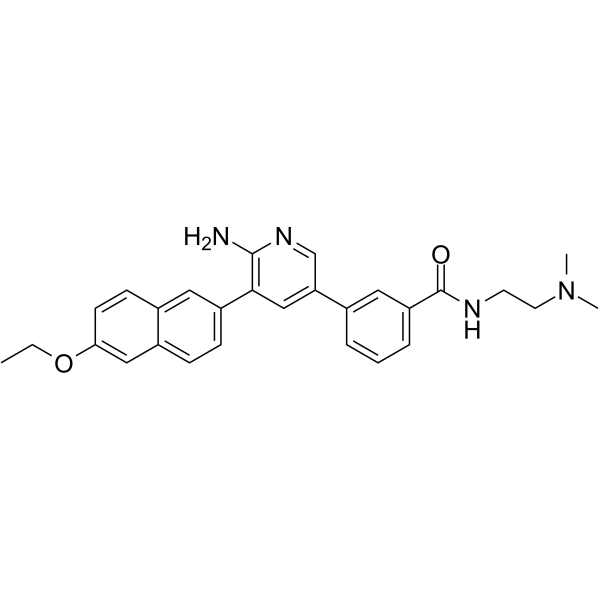
-
- HY-14147
-
|
BRL 24924
|
5-HT Receptor
|
Metabolic Disease
|
|
Renzapride (BRL 24924), a substituted benzamide, is a full 5-HT4 receptor agonist with a Ki value of 115 nM. Renzapride (BRL 24924) is also a 5HT2b and 5HT3 receptor antagonist . Renzapride could be used for constipation predominant irritable bowel syndrome (C-IBS) study .
|
-
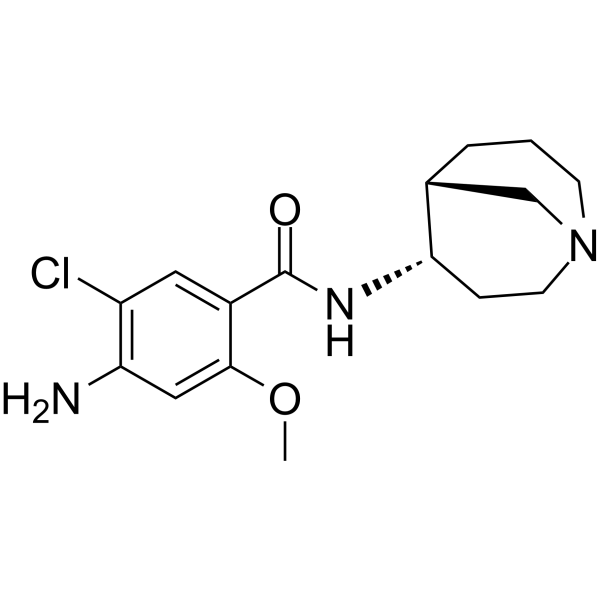
-
- HY-B1019R
-
|
|
Dopamine Receptor
|
Neurological Disease
|
|
Sulpiride (Standard) is the analytical standard of Sulpiride. This product is intended for research and analytical applications. Sulpiride is an orally active dopamine D2/D3 receptor antagonist. Sulpiride is an atypical antipsychotic agent of the benzamide family. Sulpiride can be used in research into anxiety, depression and breast cancer .
|
-
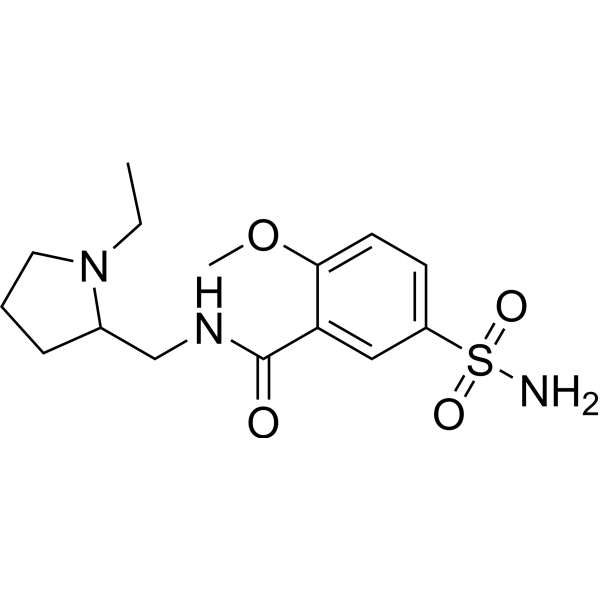
-
- HY-145815
-
|
|
HDAC
PROTACs
|
Cancer
|
|
JPS014 is a benzamide-based Von Hippel-Lindau (VHL) E3-ligase proteolysis targeting chimeras (PROTAC). JPS014 degrades class I histone deacetylase (HDAC). JPS014 is potent HDAC1/2 degrader correlated with greater total differentially expressed genes and enhanced apoptosis in HCT116 cells .
|
-
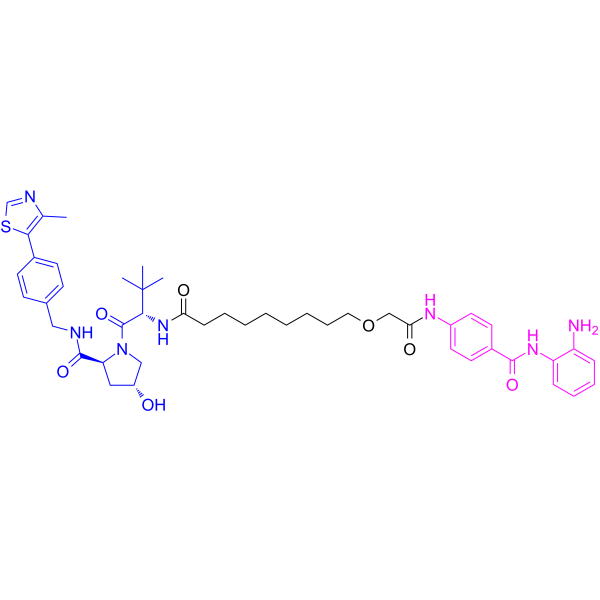
-
- HY-145816
-
|
|
HDAC
PROTACs
|
Cancer
|
|
JPS016 is a benzamide-based Von Hippel-Lindau (VHL) E3-ligase proteolysis targeting chimeras (PROTAC). JPS016 degrades class I histone deacetylase (HDAC). JPS016 is potent HDAC1/2 degrader correlated with greater total differentially expressed genes and enhanced apoptosis in HCT116 cells .
|
-
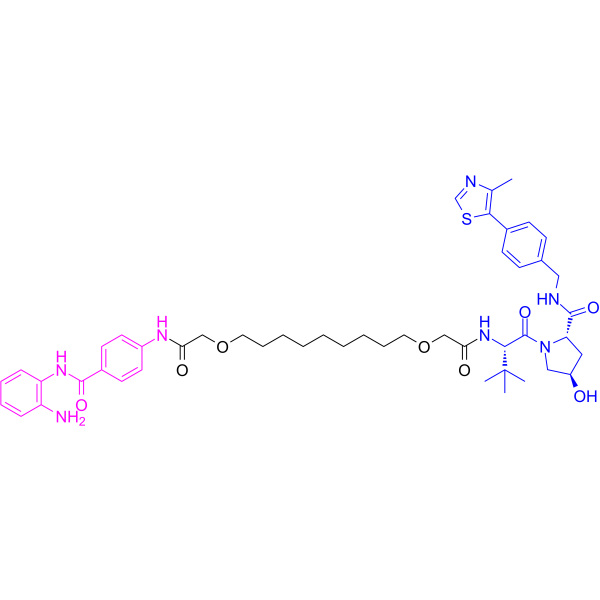
-
- HY-145818
-
|
|
HDAC
PROTACs
|
Cancer
|
|
JPS035 is a benzamide-based Von Hippel-Lindau (VHL) E3-ligase proteolysis targeting chimeras (PROTAC). JPS035 degrades class I histone deacetylase (HDAC). JPS035 is potent HDAC1/2 degrader correlated with greater total differentially expressed genes and enhanced apoptosis in HCT116 cells .
|
-

-
- HY-145819
-
|
|
HDAC
PROTACs
|
Cancer
|
|
JPS036 is a benzamide-based Von Hippel-Lindau (VHL) E3-ligase proteolysis targeting chimeras (PROTAC). JPS036 degrades class I histone deacetylase (HDAC). JPS036 is potent HDAC1/2 degrader correlated with greater total differentially expressed genes and enhanced apoptosis in HCT116 cells .
|
-
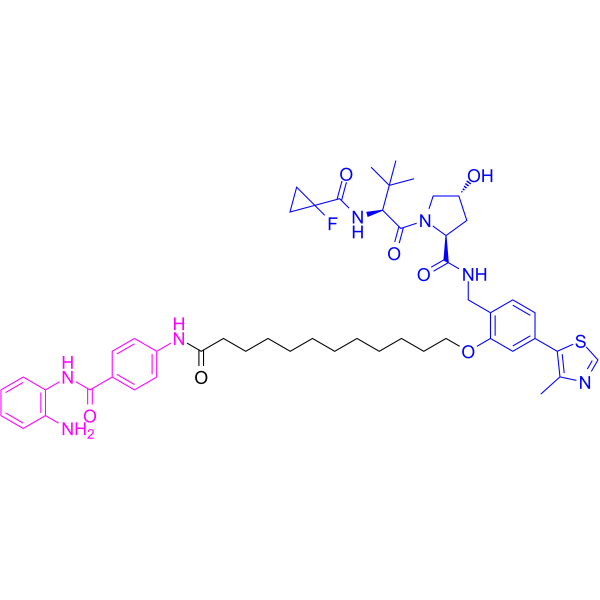
-
- HY-145816A
-
|
|
HDAC
PROTACs
|
Cancer
|
|
JPS016 is a benzamide-based Von Hippel-Lindau (VHL) E3-ligase proteolysis targeting chimeras (PROTAC). JPS016 degrades class I histone deacetylase (HDAC). JPS016 is potent HDAC1/2 degrader correlated with greater total differentially expressed genes and enhanced apoptosis in HCT116 cells .
|
-
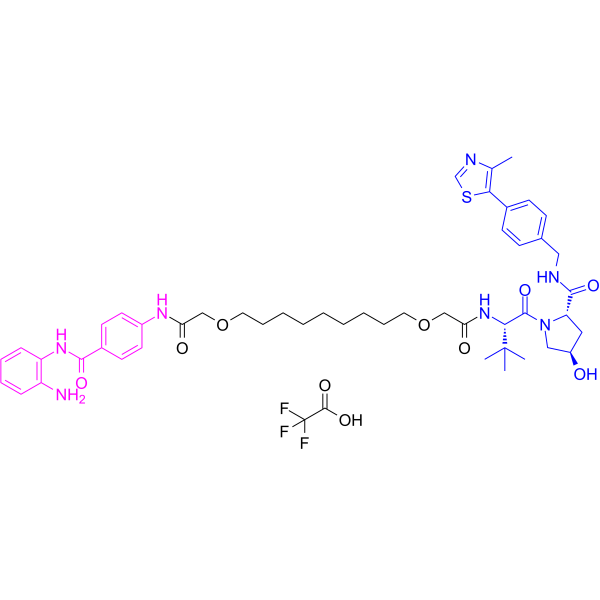
-
- HY-P4154
-
|
ALM-488
|
Fluorescent Dye
|
Neurological Disease
|
|
Bevonescein (ALM-488) is a novel, intravenously-administrated fluorescein-conjugated peptide that binds nerve-associated connective tissue, labels peripheral nerves under real-time fluorescence imaging (FL) in living mice and human ex vivo nerve tissue. Bevonescein is a peptide-linked tracer which fluorescently labeled both intact and degenerated nerves .
|
-
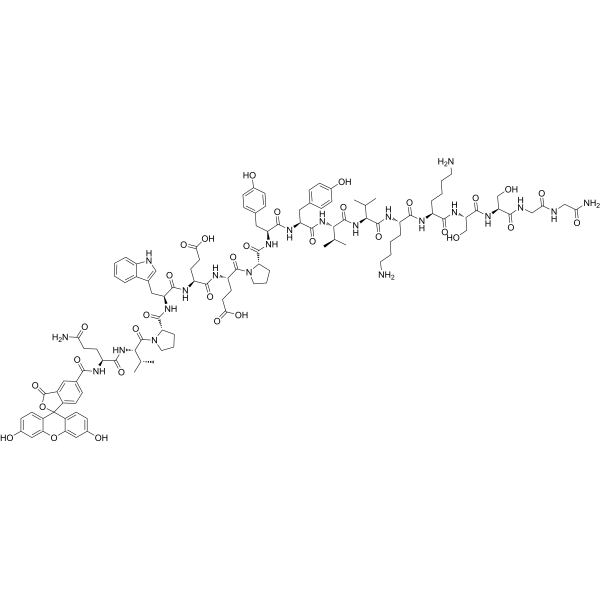
-
- HY-145815A
-
|
|
PROTACs
HDAC
Apoptosis
|
Cancer
|
|
JPS014 TFA is a benzamide-based Von Hippel-Lindau (VHL) E3-ligase proteolysis targeting chimeras (PROTAC). JPS014 TFA degrades class I histone deacetylase (HDAC). JPS014 TFA is potent HDAC1/2 degrader correlated with greater total differentially expressed genes and enhanced apoptosis in HCT116 cells .
|
-
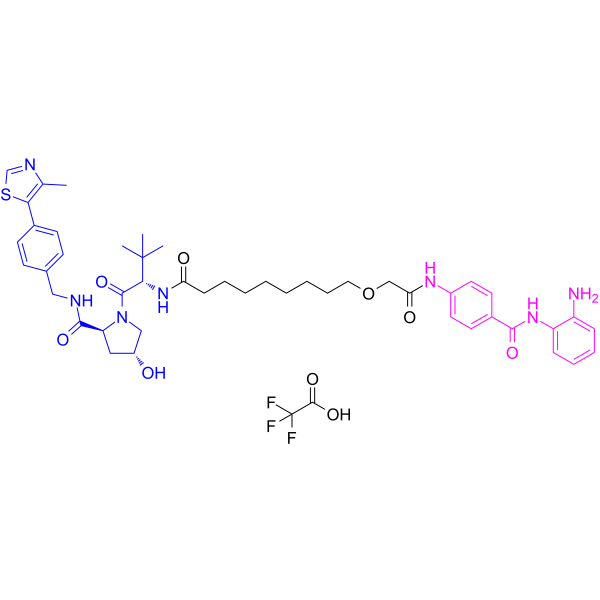
-
- HY-P1103A
-
|
|
CXCR
|
Cancer
|
|
CTCE-9908 TFA is a potent and selective CXCR4 antagonist. CTCE-9908 TFA induces mitotic catastrophe, cytotoxicity and inhibits migration in CXCR4-expressing ovarian cancer cells .
|
-
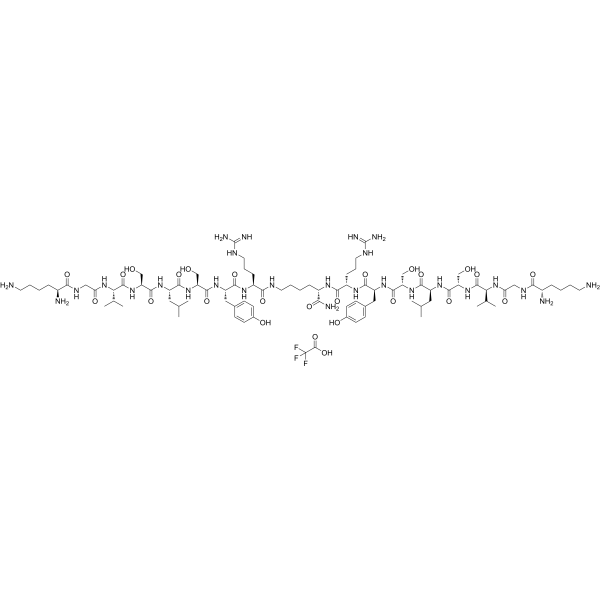
-
- HY-P1103
-
|
|
CXCR
|
Cancer
|
|
CTCE-9908 is a potent and selective CXCR4 antagonist. CTCE-9908 induces mitotic catastrophe, cytotoxicity and inhibits migration in CXCR4-expressing ovarian cancer cells .
|
-
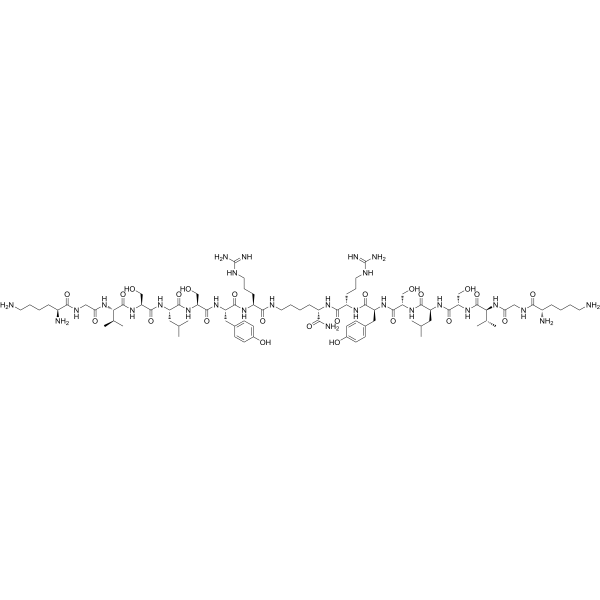
-
- HY-P2231A
-
|
MEDI0382 acetate
|
GCGR
|
Metabolic Disease
|
|
Cotadutide (MEDI0382) acetate is a potent dual agonist of glucagon-like peptide-1 (GLP-1) and GCGR with EC50 values of 6.9 pM and 10.2 pM, respectively. Cotadutide acetate exhibits ability to facilitate both weight loss and glycaemic control, and alleviate fibrosis. Cotadutide acetate can be used in the research of obesity and type 2 diabetes (T2D) .
|
-
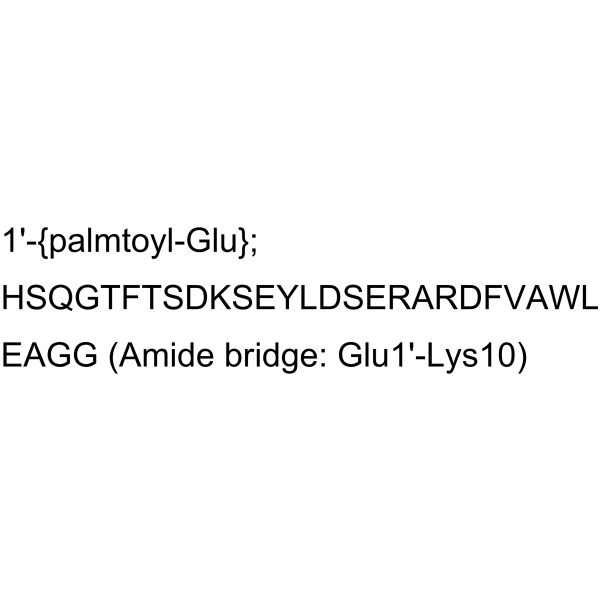
-
- HY-P2231
-
|
MEDI0382
|
GCGR
|
Metabolic Disease
|
|
Cotadutide (MEDI0382) is a potent dual agonist of glucagon-like peptide-1 (GLP-1) and GCGR with EC50 values of 6.9 pM and 10.2 pM, respectively. Cotadutide exhibits ability to facilitate both weight loss and glycaemic control, and alleviate fibrosis. Cotadutide can be used in the research of obesity and type 2 diabetes (T2D) .
|
-
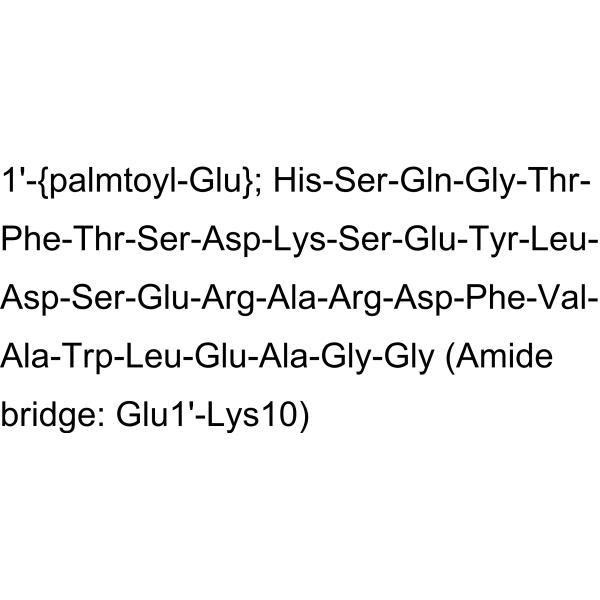
-
- HY-155355
-
|
|
iGluR
|
Neurological Disease
|
|
LY836 is an orally active neuroprotective agent. LY836 significantly blocks PSD95-nNOS association in cortical neurons. LY836 can be used in study ischemic stroke .
|
-
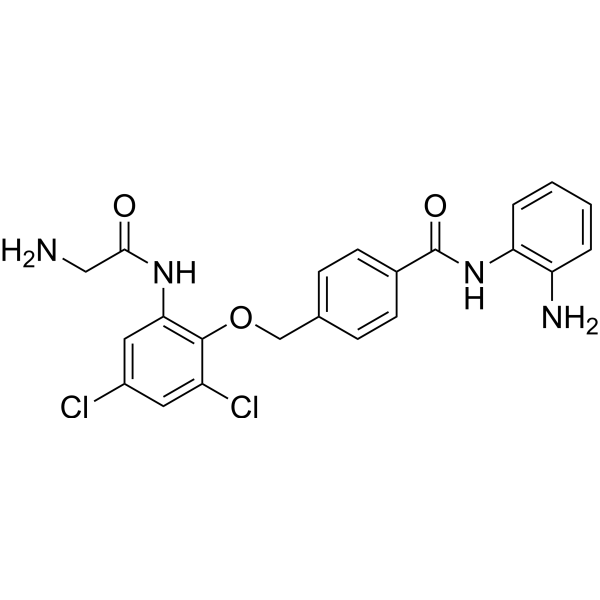
-
- HY-W357200
-
|
N-[9-(6-Hydroxymethyl-4-trityl-morpholin-2-yl)-9H-purin-6-yl]-Benzamide
|
Nucleoside Antimetabolite/Analog
|
Cancer
|
|
N6-Benzoyl-7’-OH-N-trityl morpholino adenine is a purine nucleoside analog. Purine nucleoside analogs have broad antitumor activity targeting indolent lymphoid malignancies. Anticancer mechanisms in this process rely on inhibition of DNA synthesis, induction of apoptosis, etc .
|
-

-
- HY-W357201
-
|
N-[1-(6-Hydroxymethyl-4-trityl-morpholin-2-yl)-2-oxo-1,2-dihydro-pyrimidin-4-yl]-Benzamide
|
Nucleoside Antimetabolite/Analog
|
Cancer
|
|
N4-Benzoyl-7’-OH-N-trityl morpholino cytosine is a purine nucleoside analog. Purine nucleoside analogs have broad antitumor activity targeting indolent lymphoid malignancies. Anticancer mechanisms in this process rely on inhibition of DNA synthesis, induction of apoptosis, etc .
|
-
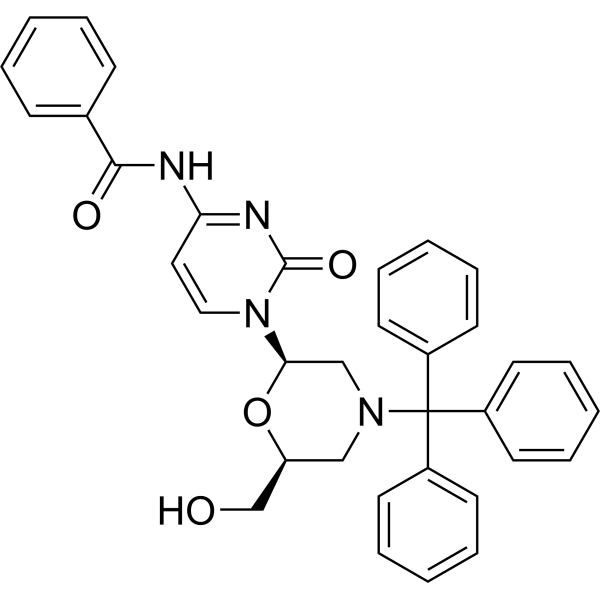
-
- HY-P1321
-
|
1229U91; GW1229
|
Neuropeptide Y Receptor
|
Neurological Disease
|
|
GR231118, an analogue of the C-terminus of neuropeptide Y, is a potent , competitive and relative seletive antagonist at human neuropeptide Y Y receptor with a pKi of 10.4. GR231118 a potent agonist at the human neuropeptide Y Y4 receptor (pEC50=8.6; pKi=9.6) and a weak agonist at the human and rat neuropeptide YY2 and Y5 receptors. GR231118 also has high affinity for the mouse neuropeptide Y Y6 receptor (pKi= 8.8) .
|
-
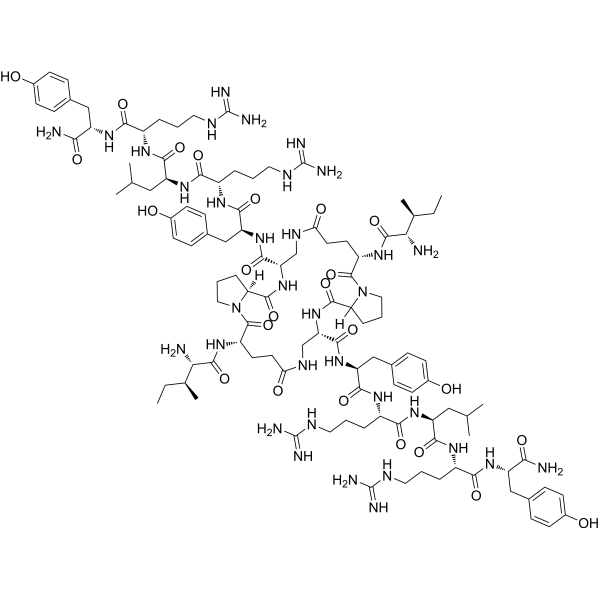
-
- HY-P1321A
-
|
1229U91 TFA; GW1229 TFA
|
Neuropeptide Y Receptor
|
Neurological Disease
|
|
GR231118 TFA, an analogue of the C-terminus of neuropeptide Y, is a potent , competitive and relative seletive antagonist at human neuropeptide YY receptor with a pKi of 10.4. GR231118 a potent agonist at the human neuropeptide YY4 receptor (pEC50=8.6; pKi=9.6) and a weak agonist at the human and rat neuropeptide Y Y2 and Y5 receptors. GR231118 also has high affinity for the mouse neuropeptide YY6 receptor (pKi= 8.8) .
|
-

-
- HY-146123
-
-
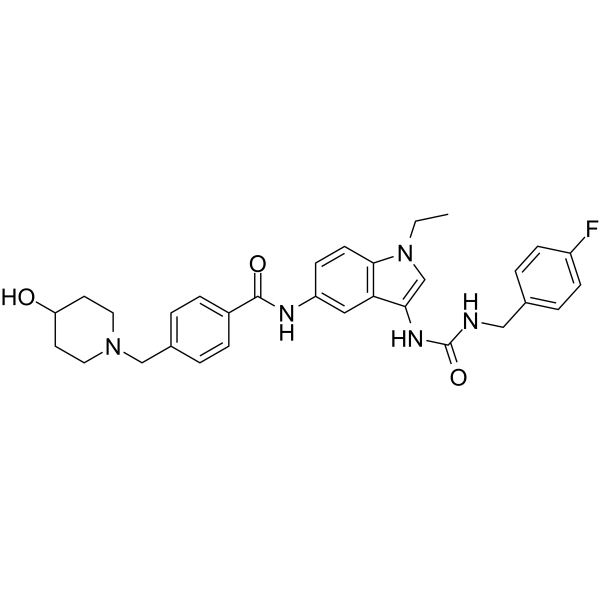
| Cat. No. |
Product Name |
Target |
Research Area |
-
- HY-P4154
-
|
ALM-488
|
Fluorescent Dye
|
Neurological Disease
|
|
Bevonescein (ALM-488) is a novel, intravenously-administrated fluorescein-conjugated peptide that binds nerve-associated connective tissue, labels peripheral nerves under real-time fluorescence imaging (FL) in living mice and human ex vivo nerve tissue. Bevonescein is a peptide-linked tracer which fluorescently labeled both intact and degenerated nerves .
|
-
- HY-P1103
-
|
|
CXCR
|
Cancer
|
|
CTCE-9908 is a potent and selective CXCR4 antagonist. CTCE-9908 induces mitotic catastrophe, cytotoxicity and inhibits migration in CXCR4-expressing ovarian cancer cells .
|
-
- HY-P2231A
-
|
MEDI0382 acetate
|
GCGR
|
Metabolic Disease
|
|
Cotadutide (MEDI0382) acetate is a potent dual agonist of glucagon-like peptide-1 (GLP-1) and GCGR with EC50 values of 6.9 pM and 10.2 pM, respectively. Cotadutide acetate exhibits ability to facilitate both weight loss and glycaemic control, and alleviate fibrosis. Cotadutide acetate can be used in the research of obesity and type 2 diabetes (T2D) .
|
-
- HY-W128037
-
-
- HY-P1103A
-
|
|
CXCR
|
Cancer
|
|
CTCE-9908 TFA is a potent and selective CXCR4 antagonist. CTCE-9908 TFA induces mitotic catastrophe, cytotoxicity and inhibits migration in CXCR4-expressing ovarian cancer cells .
|
-
- HY-P2231
-
|
MEDI0382
|
GCGR
|
Metabolic Disease
|
|
Cotadutide (MEDI0382) is a potent dual agonist of glucagon-like peptide-1 (GLP-1) and GCGR with EC50 values of 6.9 pM and 10.2 pM, respectively. Cotadutide exhibits ability to facilitate both weight loss and glycaemic control, and alleviate fibrosis. Cotadutide can be used in the research of obesity and type 2 diabetes (T2D) .
|
-
- HY-P4757
-
|
|
Peptides
|
Others
|
|
N1-Glutathionyl-spermidine disulfide is a substrate of trypanothione reductase .
|
-
- HY-P10026
-
|
LY-3457263
|
Peptides
|
Metabolic Disease
|
|
Nisotirotide (LY-3457263) is a PYY analog agonist studied in type 2 diabetes and obesity .
|
-
- HY-P1321
-
|
1229U91; GW1229
|
Neuropeptide Y Receptor
|
Neurological Disease
|
|
GR231118, an analogue of the C-terminus of neuropeptide Y, is a potent , competitive and relative seletive antagonist at human neuropeptide Y Y receptor with a pKi of 10.4. GR231118 a potent agonist at the human neuropeptide Y Y4 receptor (pEC50=8.6; pKi=9.6) and a weak agonist at the human and rat neuropeptide YY2 and Y5 receptors. GR231118 also has high affinity for the mouse neuropeptide Y Y6 receptor (pKi= 8.8) .
|
-
- HY-P1321A
-
|
1229U91 TFA; GW1229 TFA
|
Neuropeptide Y Receptor
|
Neurological Disease
|
|
GR231118 TFA, an analogue of the C-terminus of neuropeptide Y, is a potent , competitive and relative seletive antagonist at human neuropeptide YY receptor with a pKi of 10.4. GR231118 a potent agonist at the human neuropeptide YY4 receptor (pEC50=8.6; pKi=9.6) and a weak agonist at the human and rat neuropeptide Y Y2 and Y5 receptors. GR231118 also has high affinity for the mouse neuropeptide YY6 receptor (pKi= 8.8) .
|
-
- HY-P10016
-
|
HS-20039; EPO-018B
|
Peptides
|
Endocrinology
|
|
Pegmolesatide(HS-20039; EPO-018B) a synthetic peptide-based erythropoiesis-stimulating agent, can be used for ??the study of anemia in chronic kidney disease .
|
| Cat. No. |
Product Name |
Category |
Target |
Chemical Structure |
| Cat. No. |
Product Name |
Chemical Structure |
-
- HY-Z0283S
-
|
|
|
Benzamide- 15N is a 15N-labeled Benzamide. Benzamide inhibits poly(ADP-ribose) polymerase (PARP)[1][2].
|
-

-
- HY-B1059S
-
|
|
|
Levosulpiride-d3 is the deuterium labeled Levosulpiride. Levosulpiride (RV-12309) is the (S)-enantiomer of sulpiride, which is a D2 receptor a antagonist, an atypical antipsychotic agent of the benzamide class[1][2].
|
-

-
- HY-B1883S
-
|
|
|
3,5-Dichloro-N-(2-methylbut-3-yn-2-yl)benzamide-d3 is the deuterium labeled 3,5-Dichloro-N-(2-methylbut-3-yn-2-yl)benzamide[1]. 3,5-Dichloro-N-(2-methylbut-3-yn-2-yl)benzamide-d3 is a click chemistry reagent, it contains an Alkyne group and can undergo copper-catalyzed azide-alkyne cycloaddition (CuAAc) with molecules containing Azide groups.
|
-

-
- HY-B0732S
-
|
|
|
Itopride-d6 (hydrochloride) is deuterium labeled Itopride (hydrochloride). Itopride hydrochloride (HSR803), a gastroprokinetic Benzamide (HY-Z0283) derivative, is an inhibitor of acetylcholinesterase (AChE) and dopamine D2 receptor[1][2].
|
-

| Cat. No. |
Product Name |
|
Classification |
-
- HY-B1883S
-
|
|
|
Alkynes
|
|
3,5-Dichloro-N-(2-methylbut-3-yn-2-yl)benzamide-d3 is the deuterium labeled 3,5-Dichloro-N-(2-methylbut-3-yn-2-yl)benzamide[1]. 3,5-Dichloro-N-(2-methylbut-3-yn-2-yl)benzamide-d3 is a click chemistry reagent, it contains an Alkyne group and can undergo copper-catalyzed azide-alkyne cycloaddition (CuAAc) with molecules containing Azide groups.
|
Your information is safe with us. * Required Fields.
Inquiry Information
- Product Name:
- Cat. No.:
- Quantity:
- MCE Japan Authorized Agent:





















































